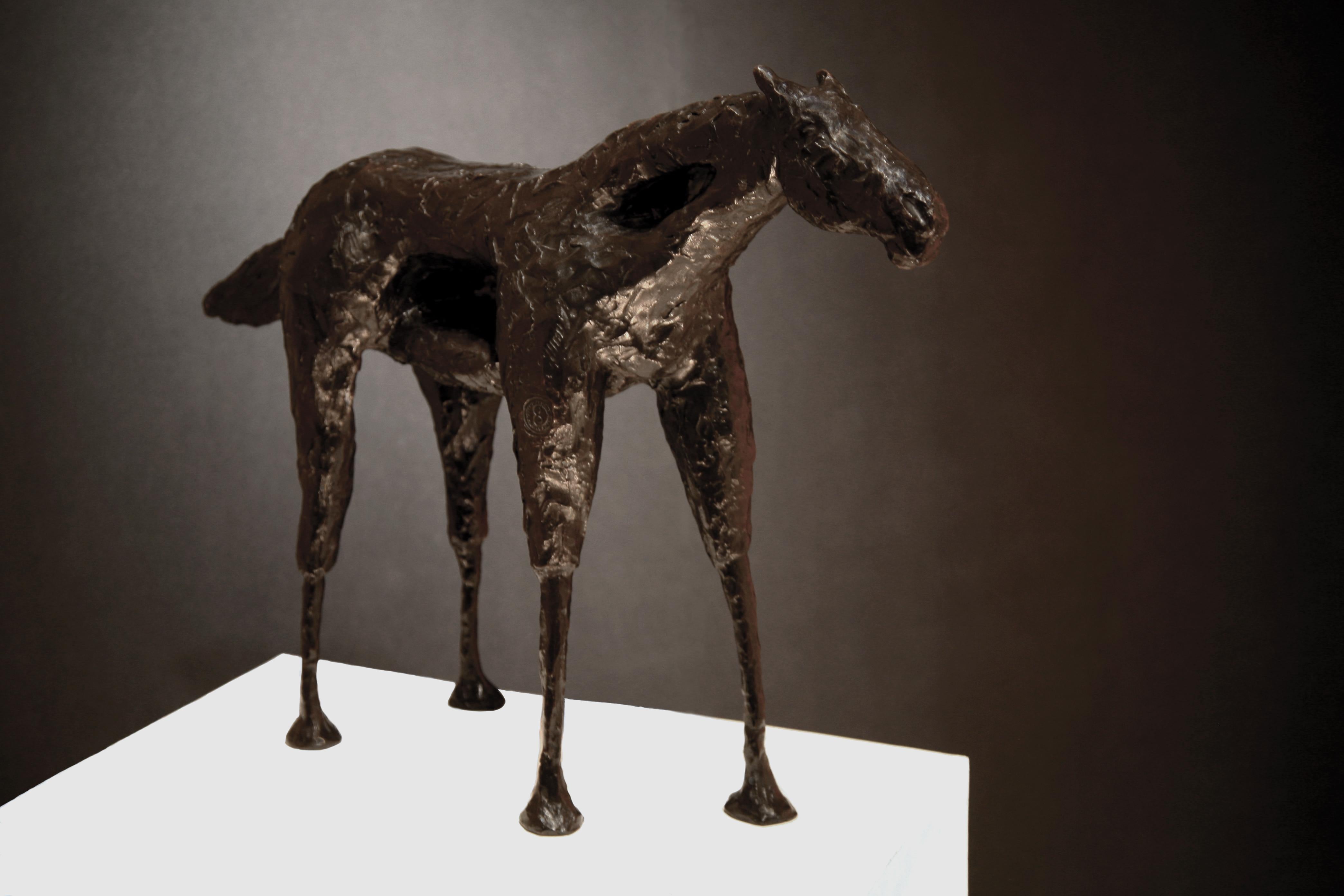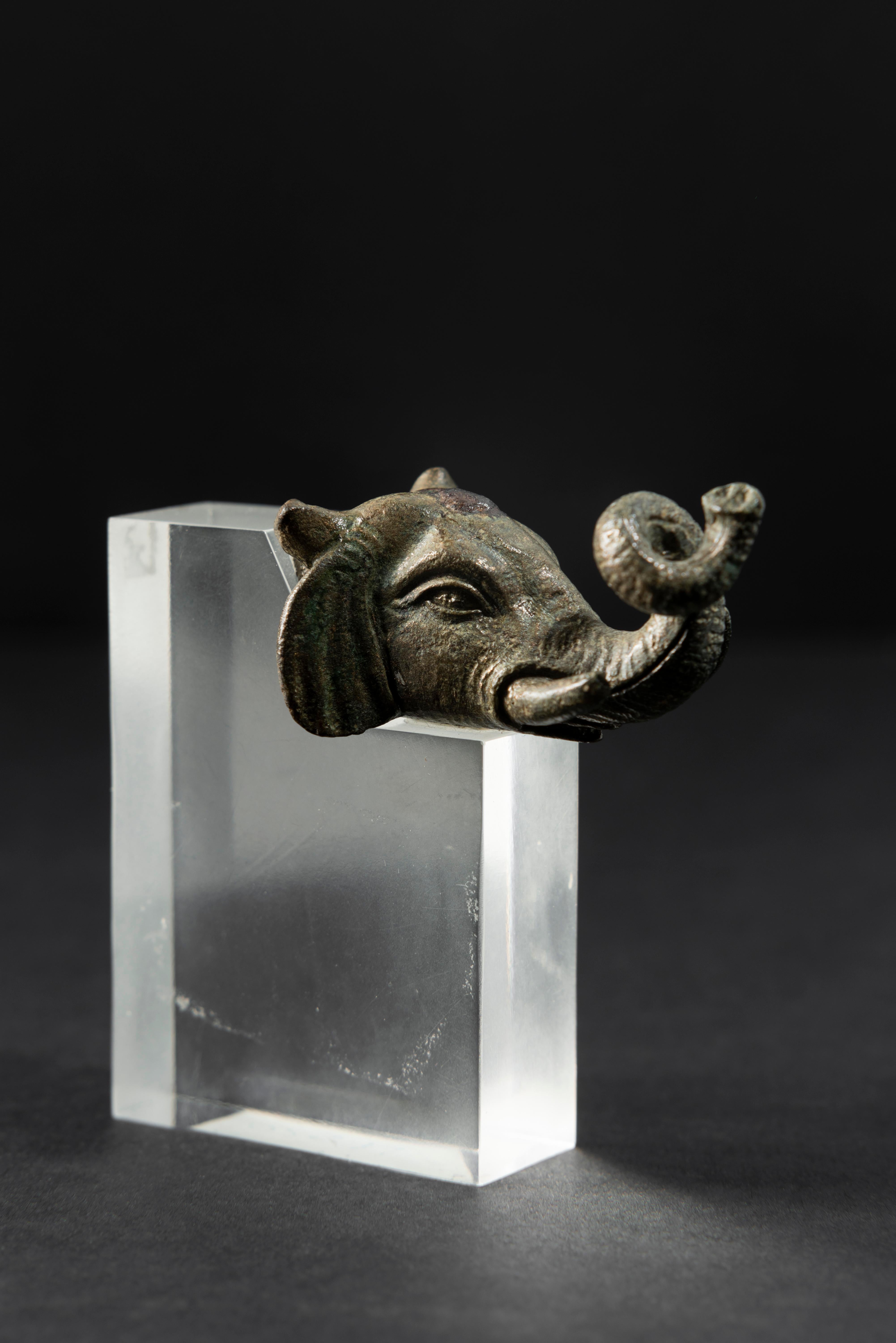Items Similar to Winston Churchill Artist Proof Bust by Ivor Roberts-Jones
Want more images or videos?
Request additional images or videos from the seller
1 of 8
Ivor Roberts-JonesWinston Churchill Artist Proof Bust by Ivor Roberts-Jones
About the Item
Ivor Roberts-Jones
1916-1996 British
Sir Winston Churchill
Artist Proof
Bronze with a green patina
One of the greatest leaders of the modern world, Winston Churchill is among the most recognizable figures in Western history. This larger-than-life green patina bronze bust by the English sculptor Ivor Roberts-Jones masterfully captures his famous visage, as well as his determined air and strong resilience.
Most notably, this glorious bust is the coveted artist's proof of this sculpture. During the commissioning of significant statues, including this one, it was customary for the artist to produce a proof which is typically the finest of all the casts.
Renowned for his resolute and unwavering guidance, Churchill's extraordinary legacy is commemorated by a monumental sculpture that captures Churchill from head to toe erected in 1971 at the heart of Parliament Square in London. The renowned British artist, Ivor Roberts-Jones, a graduate of the esteemed Royal Academy of Arts, meticulously crafted this awe-inspiring masterpiece.
Upon receiving the initial commission for this grand commission, Roberts-Jones eagerly unveiled his first interpretation of the sculpture to Lady Clementine Churchill. However, upon witnessing her husband portrayed in a suit and tie, Lady Clementine expressed her belief that the esteemed statesman should be remembered foremost as a wartime leader, insisting that the statue should embody this enduring legacy. Consequently, Roberts-Jones created the statue that currently stands in Parliament Square, the second most widely observed sculpture in the United Kingdom, surpassed only by General Nelson's column in Trafalgar Square.
This larger-than-life artwork, in its exact monumental scale, serves as the original representation of the esteemed leader. Only 1,500 smaller versions of this exceptional piece were cast, exclusively made available to members of the Churchill Society. Because of their importance, these smaller versions almost never come to market. This remarkably rare artist's proof is not only a symbol of Ivor Roberts-Jones’ greatest artistic achievement but also the lasting legacy of this great British icon.
Marked: "IRJ. AP/1"
Bust: 33 7/8" high by 48 1/2" wide by 35 1/4" deep
- Creator:Ivor Roberts-Jones (1913 - 1996, British)
- Dimensions:Height: 35.25 in (89.54 cm)Width: 48.5 in (123.19 cm)Depth: 33.88 in (86.06 cm)
- Medium:
- Period:
- Condition:
- Gallery Location:New Orleans, LA
- Reference Number:
About the Seller
5.0
Vetted Seller
These experienced sellers undergo a comprehensive evaluation by our team of in-house experts.
Established in 1912
1stDibs seller since 2013
13 sales on 1stDibs
Typical response time: 4 hours
- ShippingRetrieving quote...Ships From: New Orleans, LA
- Return PolicyThis item cannot be returned.
More From This SellerView All
- Laocoön And His Sons BronzeLocated in New Orleans, LALaocoön and his Sons Italian Bronze Group after Agesander, Polydorus and Anthenodorus Late 18th Century “The greatest piece of art in the world.” - Michelangelo, Italian sculptor, p...Category
Late 18th Century Baroque Figurative Sculptures
MaterialsBronze
- Sir Winston Churchill Memorial By Ivor Roberts-JonesBy Ivor Roberts-JonesLocated in New Orleans, LAIvor Roberts-Jones 1916-1996 | British Sir Winston Churchill Memorial Bronze This exceptional and iconic sculpture of Sir Winston Churchill is the original maquette for the renown...Category
20th Century Academic Figurative Sculptures
MaterialsBronze
- Married Love by Oscar NemonLocated in New Orleans, LAOscar Nemon 1906 - 1985 Croatian Married Love Signed “Nemon” (on reverse) Bronze resin with green patina This rousing and sentimental sculpture, commis...Category
20th Century Figurative Sculptures
MaterialsBronze
- Bronze of Pluto Abducting Proserpine after François GirardonLocated in New Orleans, LAAfter François Girardon 1628-1715 French Pluto Abducting Proserpine Bronze This High Baroque period composition captures the famed narrative of Pluto and Proserpine from Roman mythology. The late 17th-century patinated bronze, created after François Girardon's marble composition, captures the very moment that Pluto seizes Proserpine. The anguished goddess reaches skyward, attempting to escape the god’s grasp while Pluto’s stoic face betrays his knowledge that his ploy will succeed. This pivotal moment in the mythological tale has captured the imagination of many art historical greats, from Bernini to Rubens. François Girardon’s version of the climax demonstrates incredible finesse and artistry, modeled expertly in bronze in the present work by a later sculptor. The statue brings a twist of intertwined bodies into a dynamic frenzy, paralleling the tension of the legendary story. In ancient Roman mythology, Proserpine, the beautiful daughter of Ceres — known as Persephone in Greek mythology — was picking flowers in the fields when she was suddenly abducted by Pluto, the god of the underworld, and taken to his kingdom. Consumed with grief, her mother Ceres, the goddess of agriculture, scorches the earth, stopping the growth of grain and fruit. Jupiter attempts to intervene and secure Proserpine’s return to earth, negotiating a compromise with Pluto and the Fates that allows Proserpine to be released for part of the year before returning to Pluto’s underworld. Proserpine’s journey back and forth is an allegory for the changing seasons; when Prosperine is with her mother, the earth warms and provides bountiful harvests. Upon her annual return to the underworld, however, the earth once again becomes cold and barren. After returning to France after years of training in Rome, François Girardon quickly rose to become one of the greatest artists in France. He was elected a member of the Académie Royale de Peinture et de Sculpture in 1657 and would become Chancellor of the Royal Academy in 1695. The artist was approached frequently for royal commissions and Girardon’s Pluto was originally commissioned by Louis XIV for the gardens at his Palace of Versailles. It was one of four monumental marble groups intended to decorate the corners of Charles Le Brun’s never completed garden at the chateau, the Parterre d’Eau. Each group of three figures symbolized one of the four elements: earth, air, fire and water. Pluto’s association with hell made him the apt...Category
Early 18th Century Baroque Figurative Sculptures
MaterialsBronze
- Arabesque on Right Side, Right Hand Close to Earth, Left Arm OutsideBy Edgar DegasLocated in New Orleans, LAOne of a series of sculpted dancers created by the incomparable Edgar Degas, this exceptional bronze exudes all of the expressivity one expects from this 20th-century great. Degas captures the essence of his model in the graceful work, as she strikes a particularly difficult pose of the arabesque. The dancer's features have been manipulated and simplified, executed in a manner that seems almost as if one of Degas' Impressionist canvases has come to life. Degas was obsessed with capturing the dancer in motion throughout his career. He rendered their grace and movement in oil, pastel, pencil, chalk and wax - in fact, of the seventy-four wax sculptures created by Degas during his lifetime, forty of them depicted dancers. Seven of these belong to his series that capture the various forms of the arabesque, and the present work is included among them. It details one of the most difficult and animated poses of the ballet. Degas’ dancer is precariously posed in a study of balance and motion, one leg gracefully thrust into the air as she tilts her body down towards the earth and extends her arm forward. The sense of her movement is perfectly captured in the extraordinary work, as well as the fluid lines of her body. The bronze is a sought-after rarity in terms of Degas’ sculptures. Not only are his dancers the most desirable of his work, but this bronze is also distinguished by the fact that it is a Valsuani bronze, meaning it faithfully records Degas’ wax version’s pose as it appeared at the time of its creation. Most Degas' bronzes that are found on the market were cast by Hébrard – these serialized bronzes are surmoulages, or “aftercasts,” that were cast from the modèle bronzes currently in the Norton Simon Museum (Pasadena). Because these bronzes are second generation, they are smaller and far less detailed that the current bronze. This example, however, was cast by Valsuani from a plaster that was taken directly from Degas’ waxes, according to scholarship by the art historian Dr. Gregory Hedberg. These plasters were created by Degas’ sculptor friend Albert Bartholomé shortly after Degas completed his wax figurines. Thus, they record the earliest versions of Degas’ wax sculptures, before they were damaged by time or handling, and before Degas himself altered the works. The Hébrard bronzes...Category
20th Century Impressionist Figurative Sculptures
MaterialsBronze
- CoupleBy Agustín CárdenasLocated in New Orleans, LAInfused with a crisp modernity and subtle sensuality, this bronze sculpture by Cuban-born artist Agustin Cárdenas is an exceptional example of late-2...Category
20th Century Modern Figurative Sculptures
MaterialsMarble, Bronze
You May Also Like
- NeuvoaBy Frank ArnoldLocated in Fresno, CAFrank Arnold is thought by many to be one of the foremost abstract figurative painters and sculptors of our time. He is a living master whose work is considered to be both personal a...Category
21st Century and Contemporary Abstract Abstract Sculptures
MaterialsBronze
- Caballo Arroyo (Bronze horse sculpture by Frank Arnold)By Frank ArnoldLocated in Fresno, CAFrank Arnold is thought by many to be one of the foremost abstract figurative painters and sculptors of our time. He is a living master whose work is considered to be both personal a...Category
21st Century and Contemporary Abstract Figurative Sculptures
MaterialsBronze
- Daniel Kafri, "Family", 1989, bronze sculpture, 27x17x19 cmLocated in Jerusalem, ILDani Kafri "Family", 1989 Bronze 27x17x19 cm On the last day of WW2, in Czechoslovakia – 1945, Daniel Kafri was born on the brink between mankind’s darkes...Category
1990s Figurative Sculptures
MaterialsBronze
- ANCIENT BRONZE HEAD OF AN ELEPHANT, ROMAN EMPIRE 2ND CENTURY ADLocated in Milan, ITThis beautiful cast bronze elephant head is a protome, which in ancient art was a decorative element consisting of a head - sometimes with part of the bust - of a human, animal, or f...Category
15th Century and Earlier Figurative Sculptures
MaterialsBronze
- ANCIENT ROMAN BRONZE FIGURE OF WINGED EROS RIDING A DOLPHIN, 2ND CENTURY ADLocated in Milan, ITBronze figure of a young Eros, caught in the pose of riding a dolphin. Attractive green patina, some fingers and right foot are broken. Separately worked left wing is missing. Right ...Category
15th Century and Earlier Figurative Sculptures
MaterialsBronze
- 16th Century Venetian bronze sculpture of a Young Man in ArmourLocated in Milan, IT16th Century Venetian bronze sculpture of a Young Man in Armour attributed to the Florentine artist Andrea di Alessandri, called Il Bresciano (Fl...Category
16th Century Figurative Sculptures
MaterialsBronze
Recently Viewed
View AllMore Ways To Browse
Bust Of Winston Churchill
Sir Winston Churchill
Winston Bust
Winston Churchill Sculpture
Japanese Bronze One Of Four Ryusen
Mexican Redware
Sahara Novotny
Vincent Magni
Vinh D
Weidlich Brothers
Wutthichai Chamchoi
Yabe Hirosuke
Lalanne Mouton
Virgen Caridad
18 Th Century Female Portraits
Antinous Coin
Armani Porcelain
Balloon Miguel




